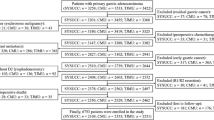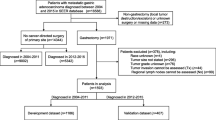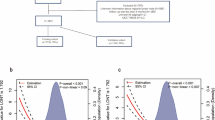Abstract
Background
The American Cancer Society projects there will be over 22,000 new cases, resulting in nearly 11,000 deaths, related to gastric adenocarcinoma in the US in 2014. The aim of the current study was to find clinicopathologic variables associated with disease-free survival (DFS) and overall survival (OS) following curative resection of gastric adenocarcinoma, and create a nomogram for individual risk prediction.
Methods
A nomogram to predict DFS and OS following surgical resection of gastric adenocarcinoma was constructed using a multi-institutional cohort of patients who underwent surgery for primary gastric adenocarcinoma at seven major institutions in the US between January 2000 and August 2013. Discrimination and calibration of the nomogram were tested by C-statistic, Kaplan–Meier curves, and calibration plots.
Results
A total of 719 patients who underwent surgery for primary gastric adenocarcinoma were included in the study. Using the backward selection of clinically relevant variables with Akaike information criteria, age, sex, tumor site, depth of invasion, and lymph node ratio (LNR) were selected as factors predictive of OS, while age, tumor site, depth of invasion, and LNR were incorporated in the prediction of DFS. A nomogram was constructed to predict OS and DFS using these variables. Discrimination and calibration of the nomogram revealed good predictive abilities (C-index, DFS 0.711; OS 0.702).
Conclusion
Independent predictors of recurrence and death following surgery for primary gastric adenocarcinoma were used to create a nomogram to predict DFS and OS. The nomogram was able to stratify patients into prognostic groups, and performed well on internal validation.




Similar content being viewed by others
References
Jemal A, Bray F, Center MM, Ferlay J, Ward E, Forman D. Global cancer statistics [published erratum appears in CA Cancer J Clin. 2011;61(2):134]. CA Cancer J Clin. 2011;61(2):69–90.
Crew KD, Neugut AI. Epidemiology of gastric cancer. World J Gastroenterol. 2006;12(3):354–62.
Siegel R, Ma J, Zou Z, Jemal A. Cancer statistics, 2014. CA Cancer J Clin. 2014;64(1):9–29.
Dikken JL, van de Velde CJ, Coit DG, Shah MA, Verheij M, Cats A. Treatment of resectable gastric cancer. Therap Adv Gastroenterol. 2012;5(1):49–69.
Lee SE, Ryu KW, Nam BH, et al. Prognostic significance of intraoperatively estimated surgical stage in curatively resected gastric cancer patients. J Am Coll Surg. 2009;209(4):461–7.
Deng J, Liang H, Wang D, Sun D, Pan Y, Liu Y. Investigation of the recurrence patterns of gastric cancer following a curative resection. Surg Today. 2011;41(2):210–5.
Wu CW, Lo SS, Shen KH, et al. Incidence and factors associated with recurrence patterns after intended curative surgery for gastric cancer. World J Surg. 2003;27(2):153–8.
Huang KH, Chen JH, Wu CW, et al. Factors affecting recurrence in node-negative advanced gastric cancer. J Gastroenterol Hepatol. 2009;24(9):1522–6.
Sakar B, Karagol H, Gumus M, et al. Timing of death from tumor recurrence after curative gastrectomy for gastric cancer. Am J Clin Oncol. 2004;27(2):205–9.
Arrington AK, Nelson R, Patel SS, et al. Timing of chemotherapy and survival in patients with resectable gastric adenocarcinoma. World J Gastrointest Surg. 2013;5(12):321–8.
Degiuli M, Sasako M, Ponti A, et al. Randomized clinical trial comparing survival after D1 or D2 gastrectomy for gastric cancer. Br J Surg. 2014;101(2):23–31.
Miceli R, Tomasello G, Bregni G, Di Bartolomeo M, Pietrantonio F. Adjuvant chemotherapy for gastric cancer: current evidence and future challenges. World J Gastroenterol. 2014;20(16):4516–25.
Markar SR, Karthikesalingam A, Jackson D, Hanna GB. Long-term survival after gastrectomy for cancer in randomized, controlled oncological trials: comparison between West and East. Ann Surg Oncol. 2013;20(7):2328–38.
Kim JH, Kim HS, Seo WY, et al. External validation of nomogram for the prediction of recurrence after curative resection in early gastric cancer. Ann Oncol. 2012;23(2):361–7.
Isozaki H, Okajima K, Fujii K, et al. Effectiveness of paraaortic lymph node dissection for advanced gastric cancer. Hepatogastroenterology. 1999;46(25):549–54.
Berardi R, Scartozzi M, Romagnoli E, Antognoli S, Cascinu S. Gastric cancer treatment: a systematic review. Oncol Rep. 2004;11(4):911–6.
Dickson JL, Cunningham D. Systemic treatment of gastric cancer. Eur J Gastroenterol Hepatol. 2004;16(3):255–63.
Edge SB, Compton CC. The American Joint Committee on Cancer: the 7th edition of the AJCC cancer staging manual and the future of TNM. Ann Surg Oncol. 2010;17(6):1471–4.
Zu H, Wang F, Ma Y, Xue Y. Stage-stratified analysis of prognostic significance of tumor size in patients with gastric cancer. PloS One. 2013;8(1):e54502.
Kunisaki C, Makino H, Kimura J, et al. Impact of lymphovascular invasion in patients with stage I gastric cancer. Surgery. 2010;147(2):204–11.
Li C, Oh SJ, Kim S, et al. Macroscopic Borrmann type as a simple prognostic indicator in patients with advanced gastric cancer. Oncology. 2009;77(3–4):197–204.
Kunisaki C, Akiyama H, Nomura M, et al. Clinicopathologic characteristics and surgical outcomes of mucinous gastric carcinoma. Ann Surg Oncol. 2006;13(6):836–42.
Kunisaki C, Akiyama H, Nomura M, et al. Surgical outcomes in patients with T4 gastric carcinoma. J Am Coll Surg. 2006;202(2):223–30.
Talamonti MS, Kim SP, Yao KA, et al. Surgical outcomes of patients with gastric carcinoma: the importance of primary tumor location and microvessel invasion. Surgery. 2003;134(4):720–727; discussion 727–729.
Iasonos A, Schrag D, Raj GV, Panageas KS. How to build and interpret a nomogram for cancer prognosis. J Clin Oncol. 2008;26(8):1364–70.
Kattan MW, Karpeh MS, Mazumdar M, Brennan MF. Postoperative nomogram for disease-specific survival after an R0 resection for gastric carcinoma. J Clin Oncol. 2003;21(19):3647–50.
Kong SH, Lee HJ, Ahn HS, et al. Stage migration effect on survival in gastric cancer surgery with extended lymphadenectomy: the reappraisal of positive lymph node ratio as a proper N-staging. Ann Surg. 2012;255(1):50–8.
Harrell FE Jr, Califf RM, Pryor DB, Lee KL, Rosati RA. Evaluating the yield of medical tests. JAMA. 1982;247(18):2543–6.
Strong VE, Song KY, Park CH, et al. Comparison of gastric cancer survival following R0 resection in the United States and Korea using an internationally validated nomogram. Ann Surg. 2010;251(4):640–6.
Strong VE, Song KY, Park CH, et al. Comparison of disease-specific survival in the United States and Korea after resection for early-stage node-negative gastric carcinoma. J Surg Oncol. 2013;107(6):634–40.
Marrelli D, De Stefano A, de Manzoni G, Morgagni P, Di Leo A, Roviello F. Prediction of recurrence after radical surgery for gastric cancer: a scoring system obtained from a prospective multicenter study. Ann Surg. 2005;241(2):247–55.
Posteraro B, Persiani R, Dall’Armi V, et al. Prognostic factors and outcomes in Italian patients undergoing curative gastric cancer surgery. Eur J Surg Oncol. 2014;40(3):345–51.
Han DS, Suh YS, Kong SH, et al. Nomogram predicting long-term survival after d2 gastrectomy for gastric cancer. J Clin Oncol. 2012;30(31):3834–40.
Hirabayashi S, Kosugi S, Isobe Y, et al. Development and external validation of a nomogram for overall survival after curative resection in serosa-negative, locally advanced gastric cancer. Ann Oncol. 2014;25(6):1179–84.
Song KY, Park YG, Jeon HM, Park CH. A nomogram for predicting individual survival of patients with gastric cancer who underwent radical surgery with extended lymph node dissection. Gastric Cancer. 2014;17(2):287–93.
Novotny AR, Schuhmacher C, Busch R, Kattan MW, Brennan MF, Siewert JR. Predicting individual survival after gastric cancer resection: validation of a U.S.-derived nomogram at a single high-volume center in Europe. Ann Surg. 2006;243(1):74–81.
Disclosure
Yuhree Kim, Gaya Spolverato, Aslam Ejaz, Malcolm H. Squires, George Poultsides, Ryan C. Fields, Mark Bloomston, Sharon M. Weber, Konstantinos Votanopoulos, Alexandra W. Acher, Linda X. Jin, BS, William G. Hawkins, Carl Schmidt, David Kooby, David Worhunsky, Neil Saunders, Edward A. Levine, Clifford S. Cho, Shishir K. Maithel, Timothy M. Pawlik have nothing to disclose.
Author information
Authors and Affiliations
Corresponding author
Electronic Supplementary Material
Below is the link to the electronic supplementary material.
Rights and permissions
About this article
Cite this article
Kim, Y., Spolverato, G., Ejaz, A. et al. A Nomogram to Predict Overall Survival and Disease-Free Survival After Curative Resection of Gastric Adenocarcinoma. Ann Surg Oncol 22, 1828–1835 (2015). https://doi.org/10.1245/s10434-014-4230-4
Received:
Published:
Issue Date:
DOI: https://doi.org/10.1245/s10434-014-4230-4




